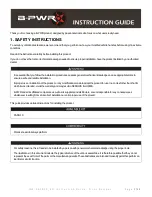
2. Remove the fuel tank, air filter housing and the
surge tank as described in this chapter.
3. Remove the neck covers (Chapter Fourteen).
4. Note how the choke cable is routed along the
frame and through the fork legs. The new cable will
have to follow the same path.
5. At the carburetor, loosen the cable clamp screw
(A,
Figure 88
) and disconnect the choke cable end
(B) from the choke linkage.
6. At the left handlebar switch, remove the screw
(B,
Figure 87
) and lower the cover from the bottom
of the switch.
7. Disconnect the cable end from the choke lever
fitting (
Figure 89
) and remove the cable from the
switch housing.
8. Release the choke cable from any ties or holders
(
Figure 86
) that secure the choke cable in place.
The ties or holders must be reinstalled in their origi-
nal locations.
9. Tie a piece of heavy string or cord to the carbure-
tor end of the choke cable. Wrap this end with tape.
Do not use an excessive amount of tape. Too much
tape could interfere with the cable’s passage
through the frame.
10. Starting at the choke lever, carefully pull the
cable from the motorcycle, following the path of the
original cable.
11. Lubricate the new cable as described in Chap-
ter Three.
12. Untie the string from the old cable and tie it to
the carburetor end of the new cable.
13. Carefully pull the string back through the
frame, routing the new cable through the same path
as the old.
14. Remove the string and lubricate the cable end
with lithium soap grease.
15. Connect the cable end (B,
Figure 88
) to the
choke linkage and secure the cable with the clamp
screw (A).
16. At the handlebar, lubricate the cable end with
lithium soap grease and connect the cable to the
choke lever linkage (
Figure 89
).
17. Operate the choke lever and check the opera-
tion of the carburetor starter valve assembly. If it
does not operate properly or if it is binding, make
sure the cable is correctly attached, and check for
tight bends in the cable.
18. Secure the handlebar switch cover in place with
its mounting screw (B,
Figure 87
).
FUEL FILTER
All models are equipped with a separate fuel filter
that cannot be cleaned. The fuel filter must be re-
placed whenever it is dirty or at the interval speci-
fied in
Table 1
in Chapter Three.
Removal/Installation
1. Remove the rider and passenger seats as de-
scribed in Chapter Fourteen.
2. Disconnect the electrical lead (
Figure 2
) from
the negative battery terminal.
3. Remove the fuel tank as described in this chap-
ter.
4. Remove the ignitor panel (B,
Figure 76
) as de-
scribed in Chapter Fourteen.
5. Disconnect the inlet and outlet hoses from the
fuel filter (A,
Figure 90
).
6. Remove the filter from the rubber grommet (B,
Figure 90
).
7. Installation is the reverse of removal. Note the
following:
a. Securely seat the filter in its grommet.
AIR/FUEL, EXHAUST AND EMISSION CONTROL SYSTEMS
229
8
89
90
















































